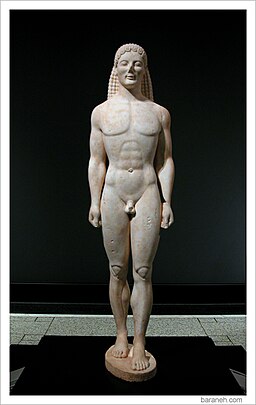Home › Forums › Ancient Civilizations › How were Greek statues displayed?
- This topic has 3 voices and 4 replies.
-
AuthorPosts
-
August 5, 2014 at 4:44 am #3813
 scout1067Participant
scout1067ParticipantI saw this today: Outcry after ancient Greek statues snapped in tulle and feathersIt got me to wondering how Greek statues were displayed. I think I remember reading somewhere that many Greek and Roman statues were displayed fully clothed. Now I don't think the Greeks would have put a feather boa or leopard print thong on a statue but am I correct in thinking that statues were clothed by the ancients?
August 5, 2014 at 6:00 am #30161 AethelingParticipant
AethelingParticipantDifficult to say if those statues were clothed or not but painted for sure:http://harvardmagazine.com/2007/11/dazzlers-htmlNow, about the outcry you are referring to, I don't understand why people are so shocked about that! What we can see today might be very different than how it looked in the past (especially about churches or cathedrals which were once brightly coloured inside and outside)Here's a contemporary example of a dressed sculpture made by Edgar Degas around 1880. (Let's see how it will look like in 2000 years)
August 5, 2014 at 3:32 pm #30162 PhidippidesKeymaster
PhidippidesKeymasterGood question – I'm actually not sure whether Greek or Roman statues were displayed fully-clothed, but my hunch would say “no”. The reason is that from the days of the early Greek kouroi (male) and korai (female) statues (600 B.C.), we see that the men were carved as nude figures, whereas the females were carved as clothed figures. Even into the Classical period, males such as the Doryphoros, are carved in the nude, but females, such as the caryatids on the Erechtheion at the Acropolis, are carved clothed. As far as I'm away, it was not until the Hellenistic period that females of high stature are depicted in the nude/naked, such as the Venus Pudica statutes.I suppose this doesn't prove anything, but why would the Greeks make carved clothing distinctions if they were going to clothe the statues anyway? Besides, nudity came to represent something heroic. We can understand this in another way by the nudity of figures in Greek vase painting - obviously those figures couldn't have been covered up![html]
 [/html][html]
[/html][html]
"Museo archeologico regionale paolo orsi, kore in calcare da monte casale, 570-560 ac." by sailko - Own work (my camera). Licensed under <a title="Creative Commons Attribution 2.5
" href="http://creativecommons.org/licenses/by/2.5
">CC BY 2.5 via Wikimedia Commons.August 6, 2014 at 8:58 am #30163 scout1067Participant
scout1067ParticipantI just remembered reading somewhere that the statues in Greek temples were carved nude and clothed with the clothing changed based on the season. I could be wrong here though. I am no expert on ancient religious practice.
August 6, 2014 at 1:30 pm #30164 AethelingParticipant
AethelingParticipantPhid' analysis is really accurate and relevant; if any clothe was used on these sculptures, I don't think we will be aware of it without serious evidence but it might be possible though. Anyway, I still don't understand the reason for an outcry about the "dressed" sculpture. (I saw much more worst in modern art)
August 6, 2014 at 2:50 pm #30165 PhidippidesKeymaster
PhidippidesKeymasterScout, that could be true in some instances. Phidias cast golden clothing for the giant statue of Zeus at Olympus (one of the ancient seven wonders). I believe this was a kind of clothing that could be removed, but I could be wrong. But for most cases – especially in Roman sculpture – I'm pretty sure that nude statues were intended to be viewed as nude figures.Aeth, the outcry over the "dressed" Riace Warrior was because a) the Warriors are undoubtedly the prize and honor of Reggio Calabria, and putting a thong/boa on it (not shown in that article) is pretty shocking, and b) so much effort has been put into them that it's hardly a great idea for someone to sneakily dress them up for a photo stunt - especially without permission. I know I was pretty shocked when I first saw the story. I wondered how in the world the photographer ever got the guards to agree/look the other way while it was taking place.
-
AuthorPosts
- You must be logged in to reply to this topic.




